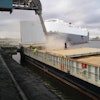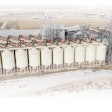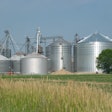In this episode of the Feed & Grain Podcast, Steven Kilger talks with John Lee, director of Safety and Health at theGrain and Feed Association of Illinois, aboutsafely entering a grain bin.
Every year lives are lost from grain bin hazards, most notably grain engulfment and entrapments. Ideally, no one would every have to enter a grain bin where there's are risks of injury and death, but there are situations where entering a grain bin with grain still in it is necessary.
By following a few basic safety steps can greatly increase the odds that entrants make it back out of the bin.
Transcript
Steven Kilger:Hi, everyone. Thanks for joining me today. I'm Steven Kilger, managing editor ofFeed & Grainand host of the Feed & Grain Podcast. Today we're talking grain bin safety. It's a perfect time of year for that, fall is coming around the corner. And well, we're going to be moving a lot of grain. So, now's a good time for a little refresher.
Joining me today is John Lee. He's the director of Safety and Health at the Grain and Feed Association of Illinois. Without further ado, thank you so much for joining me today. John, would you mind just telling me who you are and your background in the industry?
John Lee:Yeah, my name is John Lee, and I work for the Grain and Feed Association of Illinois. And my title there is director of Safety, Health and Environmental Services. And I've been doing it about 25 years. I've been in the been in safety world for about 29 years, I guess.
Kilger:Okay, cool. Well, I know you from the grain handling safety coalition. So you must do work throughout the entire industry, right?
Lee:Oh, I do. Oh, yeah. All over. Yeah. I was just at a FFA farm Winnebago-Boone County Farm Bureau meeting, for some FFA kids last week. And then the week before that I was at the Henderson County Farm Bureau meeting for kids.
Kilger:Oh, well, it's mean, that's great, though, because let's face it, safety is something that should be kind of drilled into people. As early as possible.
Lee:I want to start early.
Kilger:我在威斯康辛州南部。我们越来越漂亮close to harvest now. And so, we kind of go over some grain bin entry handling, grain bin entry, safety tips, things like that. Ideally, no one ever goes in the bin, but we all kind of know that's not realistic. So, what are some of what are the things that people should do? Before they enter a grain bin? What are some of the safety precautions they should take?
Lee:Well, back up to the beginning of it, you know, grain bin and safety starts right now, as you fill the bins, you know almost all grain and entrapments are because of poor condition grain, or a lot of soybean pods. But you can't do much about the pods. But you know, you got to dry your grain down to the moistures you want, you've got to check the bins, you've got to core the bins after harvest, so you get all the fines out of the middle. So that's step one is keeping the grain in good condition. It rarely raining traveling rarely happens when the grain is in good condition and flowing out of the bins like normal. But the main thing to do is you know you got to have at least two people you're talking on the commercial side of things, right?
Kilger:Though we do have some farm listeners and readers.
Lee:Well, I mean in the commercial industry, you have to have an entrant and an observer, that's a requirement. The observer has a full-time job, they have to stay, the observer has to stay there and watch the entrant the whole time and if the observer has to leave the entrant has to come out.
That'd be step one is never work alone, step two, I guess after grain condition. Then you know never enter when there could be grain flow. Through the unloading equipment or flow from a grain slide or unexpected movement of some sort. But you know, commercially they got to fill out a bin entry permit, that has got to be signed off by the entrant the observer and the entry supervisor and then you're going to have the observer and the entrant train on all the hazards, you know, ridging hung up. Grain condition issues can change from you know from the morning to the afternoon, as you pull grain out, pyramids can form, or a bridge could form and I've rambled on safety precautions.
Kilger:You're right on the commercial side a lot of this is required, but it's pretty good advice for people of all levels right.
Lee:Oh yes, definitely. Never enter alone, never getting into the bin with it flowing is critical. The number one cause a great entrapment is the condition, some hole reclaiming plugs up with a chunk of something corn or bean pods and somebody goes in there with a piece of PVC pipe or piece of rebar, and they stand over it start poking at it with the equipment running. That's probably 80% of all grain entrapment.
Kilger:Ah, I'm sure you've seen the movie silo that came out a few years ago. I remember sitting there watching it, and it's a great drama, but I'm also thinking to myself, Man, this whole thing would have been solved with simple like lockout tagout, wouldn't it?
Lee:Oh, yes, yes. And the grandpa that turned it on. They just leave him wandering around.
Kilger:Things these are tragedies, but they're all preventable tragedies, you know?
Lee:Oh, big time. Yes, definitely. So definitely, you know, if it's bad enough, you just, you just don't go in and try to get it from outside. There are ways to get the grain out from the outside of the bin too. Well in the commercial industry, they have tunnels from underneath. Unfortunately, on farm they don't have tunnels everywhere. Farmers don't generally have any tunnels. You can use a long pole from the entry door. Its common sense would tell you to not be in the bin if you're trying to break it.
Kilger:Yeah, yeah. Well, so you know, people get into rushes. And that's dangerous. Last year, at GEAPS, I was really excited to see this thing called the Grain weevil, which is a little robot that will go around.
Lee:Oh, God, I've seen that. I've never seen it in the field.
Kilger:They're not ready yet to.
Lee:Oh, I’ve seen the pictures.
Kilger:They look really cool. So that's pretty cool. A lot more fun to sit there with the remote-control grain weevil robot and drive it.
Lee:This year, it's shaping up to be a wet your wet corn year. And generally, in wet harvest means the next year is a big year for engulfment.
Kilger:It’s about that conditioning. Right? And getting it ready. It's harder to do when it's wet. Can we talk a little bit about some of the PPE that you would want to have on you want to wear while you're getting into a grain bin?
Lee:Well, I mean, on the commercial side of if you enter from the top, and the grain poses, according to OSHA, the grain poses and engulfment hazard, you're supposed to wear a lifeline and a harness, and it's supposed to prevent you from sinking further then waist deep. And that is very difficult to do in 90% of grain bins, because they're sloped roof and you enter from the edge of the roof. Yeah, you know, what a grain bin looks like, you can't, where do you tie it to? Where do you hook it to? There are, pulley systems with anchor points in the middle, the bins need, they need an anchor point in the middle. But anyway, so I think a minimum PPE for going in would be a dust mask, I think you got to wear a harness every time you go in whether it's tied to a point or not. Because we had to rescue you, that's something they can hook on to. Boots and dust masks in a harness.
Kilger:The dust mask is something you don't think about necessarily, because I mean, I've seen a lot of people go in without anything on their faces.
Lee:I've done it too. It's you know, you get molds. There's a lot of molds forming in, you know, corn and soybeans, they're all living organisms, and they want to grow. And if they're too wet, molds form in there, and those molds can make you really sick behave. It's called Grain Fever, or I think the technical name is toxic organic syndrome, I think. And it can make you really sick. Flu like symptoms, people, some people get so dehydrated with that they need to be taken to the hospital.
Kilger:That makes sense, especially if it's out of the condition corn, which is probably why you're in there in the first place.
Lee:Chances are if it's hung up, there's a pyramid, what I call them pyramid, the mold in there really high. Because that's what happens, the mold forms and then the little microorganisms start getting in their mold, and they all give off heat. And that's when the mold produces even more and then you get all get sick for getting them in their lung.
Kilger:Well, yeah, and then another reason to have a mask on, right?
Lee:Definitely, anyone in N95 dust mask, well is if you wear it correctly, which I would guess vast majority people don't wear correctly, you know the straps got to be not twisted and the top ones got to be at the crown of your head and the bottom was going to be below your ears. Even if you wear it correctly. They only filter out 95% of the of the dust. That's what they're designed for, so that 5% could still get you.
Kilger:The name just finally clicked in my head. Hopefully we all we all have some practice wearing masks now. Want to what kind of training do you do for people?
Lee:I do mostly commercial. The OSHA 1910.272 standard, that covers maintenance, housekeeping, bin entry. contractor safety, hazard monitoring equipment, I base everything off of that and then there's also other OSHA things, you know, lockout tagout, hazard communication, fall protection, ladder safety. I try to hit the big ones. This time of year, I do a lot of pre harvest, like, dump pit hazards.
Kilger:what can you tell me a little bit about some of the hazard monitoring equipment that people should be using?
Lee:First thing, if you have a concrete elevator or grain legs inside a structure, you have to have this hazard monitoring equipment on there. And its motion monitoring, meaning if the speed of that leg drops by more than 20% of its normal speed, which means it's pilling up, it shuts it off, so you don't burn you're leg or grain belt, which is a big loss at harvest time, of course, or it could cause an explosion. And then there's also roadblocks or touch switches. So, if that belt comes over and rides to the left or right, it bumps into those roadblocks and the roadblocks if they heat up, more than I think it's 100 degrees, I don't know, don't quote me on what the temperature is. But what if it heats up to a certain temperature, it kills the leg before it gets too hot and causes an explosion. And then they also have these little probes that route to the bearings. And they monitor the speed, the temperature of the bearings. And if they get to, I believe their preset at 140 degrees, it shuts the bearing off. So, the number one cause of grain dust explosions is bearings getting hot. And number two is rubs. So, it presents two of the biggest belt hazards.
Kilger:如果实在是没有像堵塞等等。moment you get a clog, someone's got to go in there and unclog it.
Lee:Right, right.
Kilger:So, um, the other kind of … the big conditioning one is, you see a lot of people use for grain, temperature sensing cables.
Lee:Oh, yeah, a lot of people have the grain … what do they call those things. Temperature cables, temperature cables. They're hooked to the floor. I'd say most people have those, at least the commercial side of things, I don't farmers do. And they're good. They're really good.
You know, there's, you know, Dr. Dirk Meyer Iowa State. He, he's big on reading the Co2levels. And he says that is a much better indicator of the condition of how your grain is storing. He's a big fan. He likes cables for just certain areas. But for the whole bin, the Co2monitoring is better. Because what you know that from it, your Grain ferments it gives off carbon dioxide. And then you know if that levels too high, you know, hey, you got to cool that grain.
Kilger:It's all about keeping that we're good condition.
Lee:Yeah. Because when you get you know, you probably you probably know this, you can’t chang the condition of grain. When they get the grain harvest, they can make it better. They can dry it, but the general condition of it, it doesn't get any better. The grain elevators and farmers goal is to maintain it in the condition that came in, until they get rid of it and to the market. So, you don't you can't make it better. People think they can make it better. You mean you can clean it and you can dry it, but you know, as far as the breaking up and that kind of stuff.
Kilger:It seems like we're in a … well conditions very depending on where you are in the country because like you said, it's gonna be wet here and then it's been really dry and stuff in Iowa.
Lee:The perfect bad storm would be a wet harvest, then a market conditions that that tell them to hold it like July. That's when you really got a problem, the last two years they've been shipping grain, almost immediately because they the market needs it. And you don't see nearly any holding.
Kilger:我也想象,如此多的田间存储。如果there are those conditions that say hold it, hold it, hold it, and then you're getting in those bins that are less capable than, you know, commercial operations to really monitor it.
Lee:Sure, sure. And a lot of the farmers don't have aeration systems. I think they might have the knowledge, but their bins just don't have, they can't push the air that. And some of the commercial ones don't either. But you know, they're more likely to.
Kilger:Well, they have you know, OSHA and other standards. We do go to the commercial side primarily, but, you know, their customers are farmers and producers and the people that tend to actually get hurt in these kind of grain engulfment situations. What's kind of the best course of action if they want to try to help or remind their producer customers about grain bins safety?
Lee:我的意思是,只是提醒他们的危险或谷物bins. I mean, there's probably you know, the Purdue has a statistics and I was it 30 to 40 engulfment’s a year for the last many, many years. And that their numbers are probably way low. There's probably at least twice that many.
Kilger:Well, you take out the ones that happen, never get reported.
Lee:Right. There's a lot of those a lot of those because nobody wants that publicity.
Kilger:No. I mean, I also because like you said, everyone knows, right? So it's kind of an embarrassing thing. If you're the guy who actually gets stuck in grain. Well, thank you so much for talking to me today. I don't think I have any more questions. But it's been really great chat, I think. Yeah, like I said, it's more about kind of reminding people get the thing, get the word, and not necessarily get the word out. But remind people that it needs to be constant constantly on on their mind. It needs to be something they're always thinking and talking about. So we always try to devote a lot of time this time of year to kind of grain bin rescue and safety just because well this is the time of year where it kind of all starts.
Kilger:Thank you so. I hope we get to talk again soon and open. opens a great harvest season for you.
Lee:It's a good time for me. I'm taking a vacation, so.
Kilger:Oh, excellent, perfect. Vacation, and I'll talk soon, okay, okay. All right. See you soon. All right. Bye.



















